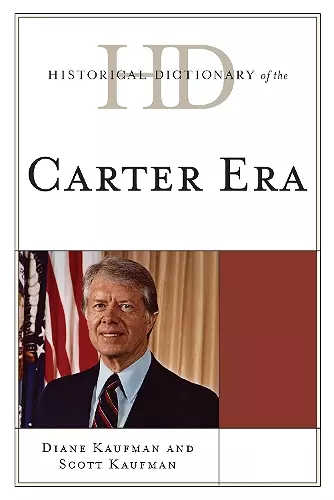Historical Dictionary of the Carter Era
Scott Kaufman author Diane Kaufman author
Format:Hardback
Publisher:Scarecrow Press
Published:28th Feb '13
Currently unavailable, and unfortunately no date known when it will be back

James Earl Carter, Jr. – better known as Jimmy Carter – was not the greatest or most popular president of the United States but he did accomplish quite a lot in the fields of civil rights, energy and foreign policy during his term from 1977 to 1981. However, the economy fared badly and he lost face in his dealings with Iran. So when he left after one term, he was not greatly missed… or so it seemed. For, after the presidency, he made an amazing comeback as a diplomat and trouble-shooter in international crises, becoming an amazing ex-president. And even the earlier views of his presidency have been improving… at least he did not get the country into a war.
This rather special trajectory is explained in the Historical Dictionary of the Carter Era, with an obvious focus on his term as president. His run for the presidency and what he did during his term in office is traced carefully by the chronology. The introduction takes a longer view and also puts events in a broader context. Then the dictionary section, with hundreds of detailed and cross-referenced entries, tells us more about his policy in various fields but also how America changed culturally and socially during this period. The extensive bibliography points toward further information, although this book is certainly a good starting point and also a place to refresh one’s memory.
Approximately 400 cross-referenced entries chronicle the one-term presidency of Jimmy Carter, covering people, politics, society, and the culture of the U.S. during the late 1970s. An introductory essay provides concise yearly summaries of each of his four years in office, including information on the energy crisis, in 1977 and the Iran hostage crisis, of 1979–80. A chronology extends from December 12, 1974 (the announcement of his candidacy), to January 21, 1981, when he was sent to Germany to greet the embassy hostages on their release after 444 days of captivity. A substantial bibliography completes the work. Recommended for school, academic, and public libraries. * Booklist *
Independent scholar/archivist D. Kaufman and S. Kaufman are the editors of this latest volume in the "Historical Dictionaries of U.S. Politics and Political Eras" series. This reference book is a dictionary with all of the expected sections, including illustrations, a chronology of the Carter presidency, an introductory essay, appendixes, and a bibliographic essay. The single thing that makes this a unique volume is that it deals with the Carter era in general rather than focusing solely on politics. Readers will find material on literature, music, and world events that ties into the period from 1977 to 1981. Entries are organized in alphabetical order and include cross-references. Most items are brief, with the exception of the entry on Jimmy Carter, which is five pages long. One distinctive feature of the entries is that the names of major players and events appear in boldface in the text and refer to other dictionary entries. This single volume would be a great addition to a school or public library because it places people and events into a chronological historical context. Summing Up: Recommended. * Choice Reviews *
American Presidents are a never-ending source of fascination and research. They set the tone for the country and the world during their tenures and American history are often discussed around presidential terms. In the newest addition to their Historical Dictionaries of U.S. Politics and Political Eras series, Scarecrow Press has tackled the four years of Jimmy Carter's presidency. Similar to their other Historical Dictionaries, this one aims to provide short entries on more subjects rather than treating any single idea or item in depth. But the coverage of their entries is broad, reaching from events that occurred during his presidency (e.g., Love Canal) to the people central to it (e.g., Ayatollah Khomeini, Tip O'Neill) to more broad entries on issues (e.g., Abortion, Environment). But the short alphabetic entries are only about half of the book. The rest is taken up by very valuable bibliography of data and primary source material. A well-organized introductory essay, a chronology of his presidency, a list of all presidential vetoes, all State of the Union addresses, approval ratings for each month he was in office, and a very thorough bibliography all make this dictionary more valuable than it would be otherwise. Libraries supporting high school and undergraduate students who research American history and politics would be well served adding this to their collection if they are looking to provide basic context for the Carter presidency. * American Reference Books Annual *
Written by a history professor at Francis Marion University and a librarian this book offers a good overview of American life during the Carter presidency. . . .[T]his title serves as a helpful resource for anyone interested in learning more about this president and the era in which he served. . . .This source is recommended for public libraries and academic libraries that support the study of American culture, American history, and political science. * Reference Reviews *
ISBN: 9780810878228
Dimensions: 235mm x 159mm x 28mm
Weight: 617g
322 pages